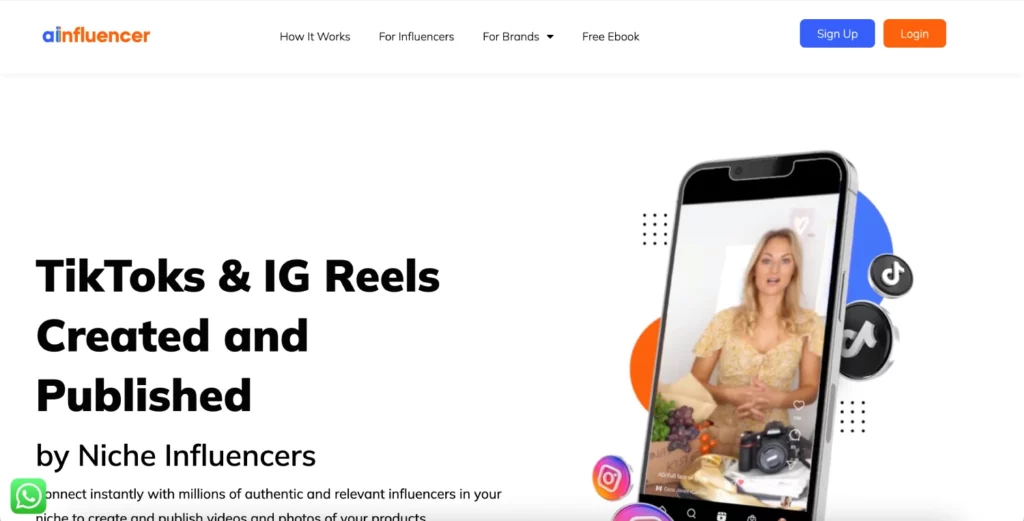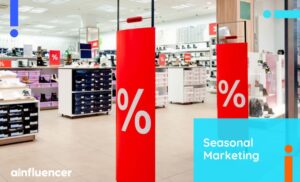Do you know what can be overwhelming for marketers in their business? Marketers often struggle to figure out which metrics they should focus on more, and Share of Voice is one of the most important metrics they should consider measuring. Share of Voice is often viewed as a key metric because it helps businesses understand their position in the market.
Wondering how? Measuring Share of Voice helps brands see how they stand in the market by putting their other social media metrics into perspective. It shows how they hold up against competitors and is a key starting point for understanding their market position to increase their brand’s visibility.
If you are looking for a quick way to improve your share of voice through influencer collaborations, Ainfluencer can be a great option.
Ainfluencer is the best free influencer marketing platform that helps brands and businesses connect with influencers. With access to thousands of influencers, brands can effortlessly set up deals and discuss terms directly through the platform’s built-in chat feature. Its powerful search tools and extensive database let brands filter influencers by location, gender, niche, and other criteria, ensuring a smooth and efficient collaboration process.
What Is the Share of Voice?
Let’s talk about SOV’s meaning and dive deeper into what it refers to. Share of Voice measures how much of the market your brand controls compared to your competitors. It shows how visible your brand is and how much influence you have within your industry. Essentially, the more of the market you control, the more popular and respected your brand is likely to be with customers.
To make it short and clean, the share of Voice actually refers to the percentage of a brand’s presence in its market compared to its competitors. It measures how much a brand dominates in advertising, social media, or overall visibility in a given sector.
Share of Voice can also mean how often a brand is talked about online and how much traffic it gets for certain keywords. Knowing your Share of Voice helps your brand understand its challenges and current market position. This gives you a clearer idea of how to grow and attract more users.
Furthermore, SOV looks at things like:
- How much you spend on ads,
- How much media coverage you get,
- And how often people mention your brand on social media.
By comparing these factors, you can understand your brand’s impact and how much attention it’s getting.
Is Share of Voice Related to Influencer Marketing?
When it comes to marketing and online presence, everything seems related. Although Share of Voice might not seem connected to influencer marketing, these two are related.
Share of Voice is related to influencer marketing because it shows how much people talk about your brand compared to others. In influencer marketing, SOV helps you understand how well your brand is performing and how much influence it has. It can also help you measure the success of your influencer marketing campaigns.
How is SOV related to influencer marketing? SOV helps measure the impact and effectiveness of your influencer campaigns. Here’s how:
- Influence of Measurement: As we mentioned before, Share of Voice (SOV) shows how much people are talking about your brand compared to your competitors. This includes mentions and discussions on social media and other platforms influenced by marketing. If influencers are frequently talking about your brand, your SOV will go up.
- Tracking Campaign Results: By tracking your SOV, you can check how well your influencer marketing is working. If your SOV is going up, it means your influencers are getting more people talking about your brand and making it more visible.
- Measuring Impact: SOV helps you see how much attention your brand is getting from influencer marketing compared to other brands. This lets you check if your influencers are doing a good job and make changes to your brand’s strategy if needed.
In summary, SOV provides insights into how well your marketing efforts are working through influencer marketing platforms by showing how much your brand holds up.
Why Should You Measure Share of Voice?
Measuring your brand’s Share of Voice will give you a better understanding of where you stand in the market. However, there are other key benefits to tracking your SOV. Here’s how it can help your brand thrive.
1. Brand Management
If you want to know how often your brand is being talked about and how many people recognize it, you need to check your Share of Voice data. This will help you understand whether the conversations people are having about your brand are positive, negative, or neutral. By tracking share of voice, you can monitor your brand’s reputation and manage your business to see:
1. How many people are aware of your brand,
2. How frequently they encounter it online,
3. How much they do discuss it.
Unexpected changes in the data could point to potential problems, like a controversy or product issue. This is especially important when launching a new campaign, as it helps you react quickly and protect your brand’s image.
2. Campaign Tracking
When you start planning to run a marketing campaign, you’ll often come across so many different campaign strategies that can increase your brand’s visibility and engagement. It’s crucial to track Share of Voice for these campaigns to see how well they’re performing and their impact.
However, you don’t have to limit your Share of Voice tracking to just your brand. You can also keep an eye on other campaigns in the market and sort the data by metrics such as country, language, or social media platform. By doing this regularly, you’ll get a better idea of what your audience likes and learn from your competitors to make your own campaigns even better.
3. Audience Insights
Did you know that social media Share of Voice metrics gather insights from real conversations happening on social platforms? These metrics analyze what people are saying about a brand or topic to understand consumer opinions and preferences.
By measuring Share of Voice, you’ll be able to understand why users and your target audience are choosing your brand over your competitors, and if not, why they aren’t.
It’s similar to Instagram metrics, where you check your insights to see why people are following or unfollowing you. These insights help you spot trends, understand what your audience likes, and find ways to improve your content and engagement.
4. Competitive analysis
The most important thing to consider when you enter any business is to analyze your competitors and see how well they are performing and what led to their success.
Understanding your competitors is important to make your brand stand out. By recognizing their strengths and weaknesses, you can create effective strategies to either close the gap or surpass them.
Measuring your Share of Voice helps you understand so many facts including:
- How does your brand compare to the competition?
- Which brand is dominating industry discussions?
- How much of the conversation do they control compared to you?
- Where are these discussions taking place?
- And what’s the overall tone of those conversations?
Knowing the answers to these questions will help you find the best ways to improve and make your brand stand out. By closely analyzing your competitors and looking at Share of Voice, you can spot new opportunities to boost your brand’s position.
Share of Voice Vs. Share of Market
Many people think that these two terms are just different ways of referring to the same thing and use them interchangeably, but that’s not the case. Now let’s talk about the differences between these two terms that can help you alot in running your business.
- Share of Market: Market Share, or Share of Market (SOM), shows what percentage of total sales in a market is held by a specific brand, business, company, or product. This percentage helps you see how much of the market’s sales are controlled by that system. It’s a useful way to know how well a brand is doing compared to its competitors.
- Share of Voice: SOV measures how much attention or visibility a brand, company, or product has compared to others in the same market. It represents the proportion of overall brand awareness associated with a specific brand, helping to gauge its prominence and influence in the industry.
Be careful not to mix these up. They somehow might seem similar in how you write or pronounce them, but they are not the same and measure two different things.
How to Measure Share of Voice?
There is a simple share of voice formula for calculating SOV that you should know:

Share of Voice = (Your Brand’s Metrics) / (Total Market Metrics)
Calculating the share of voice helps you determine your brand’s visibility and presence compared to the entire market, though the specific metrics might vary. For instance, you might track brand mentions for social media SOV and link clicks for organic search SOV. When calculating Share of Voice, you should generally focus on some key areas:
1. Social Media Share of Voice
Social Media Share of Voice is based on what people are saying about your brand on different social media platforms which includes Instagram, Facebook, and TikTok. It’s a very exact measure because it tracks real posts and conversations from customers and buyers. This helps you see how much attention and engagement your brand is getting compared to others on social media platforms.
Social media analytics tools simplify this by tracking every mention of your brand or product across various platforms. This data lets you compare your brand’s performance with your competitors to see how you stack up.
Platforms like Ainfluencer help you increase your SOV on social media by arranging partnerships with influencers. Ainfluencer allows you to work with different influencers in your niche around the world at no cost. Yes, the platform is free forever.

Plus, you can use its in-app chat feature to negotiate the terms of the agreement with your chosen influencer. From micro-influencers to major ones, Ainfluencer offers thousands of professional influencers ready for collaboration.
2. Media Share of Voice
Media share of voice is all about how often your brand is mentioned in news outlets and blogs compared to competitors. It looks at which industry-related publications are talking about your brand and the way they are discussing it.
Media share of voice also checks how many journalists or industry experts are talking about your company and if what they say is positive, neutral, or negative. By looking at this, you can see how popular and respected your brand is in your industry and among important people.
Whether the feedback is positive or negative, it will all affect your media share of voice. Journalists and industry experts often reach out to people who have interacted with your brand to ask if their experience was positive or not. So, one thing that could be very effective and needs to be taken care of is having great customer support to ensure good feedback.
3. SEO Share of Voice
Ever wondered how your brand is doing against competitors in search results? To find out, you’ll need SEO research to show how visible your brand is online compared to others. The trick is to track important metrics like impressions, clicks, and the organic keywords you’re ranking for. SEO helps you understand just how much presence your brand has on search engines.
Make sure to track your impressions, clicks, and the organic keywords you rank for. Tracking these metrics will give you a clear idea of how strong your brand’s presence is online.
4. PPC share of voice
Interested in what PPC stands for? PPC share of voice refers to how visible and prominent your pay-per-click (PPC) ads are compared to those of your competitors in a specific market or for particular keywords.
Your PPC share of voice shows how often your ads are seen by comparing how many times they could have appeared with how many times they did. You can find this information in Google Ads using a metric called Impression Share, which considers your campaign settings and keywords to give you an idea of your visibility.
How to Increase Social Media Share of Voice?
Social media is an effective way to increase your brand’s share of voice, with results you can easily measure and refine. Unlike SEO and PPC, which take time to analyze, social media allows for faster adjustments. Here are some tips to help you boost your social media share of voice.
- Stay Active on Social Media Platforms: To increase your brand’s visibility on social media, you need to post frequently and engage regularly. A single daily post will not be enough. Use analytics to find the best times to post and create a content calendar to plan and schedule your posts. Moreover, hiring a professional digital creator to create engaging content will be great.
- Create Conversations on Social Media: Get your customers to interact on social media by guiding conversations from your blog or customer service. Show the benefits, like quicker responses, on your website and how good your feedback is. This increases engagement, raises your social share of voice, and improves your brand’s reputation.
- Create Unique Social Media Content: To get people talking about your brand, create unique content that’s worth sharing. Focus on teaching, inspiring, or entertaining your target audience with tips, quotes, industry news, or funny memes. Make sure it connects with them and matches your brand.
- Go Beyond Social Media: To increase your brand’s share of voice, look beyond social media. Try guest posting on Linkedin, popular blogs, and feature influencers to get more mentions. You can start by improving your SEO to rank higher on Google by using the right keywords.
Conclusion
Understanding and improving your share of voice is important if you want to grow your brand’s visibility and reputation. By actively engaging on social media, creating unique content, and working on your brand’s marketing channels like guest posting and paid ads, you can make sure that your brand stands out in your specific market.
Keep trying and changing your strategies to connect better with your audience. With a strong share of voice, you’ll set your brand’s visibility on fire and build trust and loyalty with your customers.
FAQs
A “good” Share of Voice (SOV) percentage varies by industry and market. Generally, a higher SOV means your brand is more visible online. It’s not only about having a high number; steady growth in your SOV and being ahead of your main competitors is also a good sign. This shows that your brand is getting more attention and recognition in your area.
Impression share helps you see how many people are seeing your ads. In contrast, share of voice shows how well people know your brand overall. Impression share is often used to track how well your Pay-Per-Click (PPC) ads are doing.
Share of Voice (SOV) is often shown as a percentage. To calculate it, you take your brand’s advertising spending, media coverage, or marketing presence and divide it by the total spending or coverage in the market. As we previously told you, this helps you see how much attention your brand is getting compared to others.







![Read more about the article Best Shopify Alternatives in 2024: [Free & Paid]](https://blog.ainfluencer.com/wp-content/uploads/2024/01/featured-300x182.jpg)

